What breed of chicken?
In the comments, Bob asked what kind of chickens we have, so here goes:
 Bess is also an Auracana mix (see info on Dolley below) and she's very much the baby of the group. She has more personality than the rest of them put together--she loves to fly up to our shoulders or jump waist-high to get a treat out of our hands. She's the most voracious snail-eater of the bunch and has gotten the others interested in them too, for which we are very grateful. She lays very round little green eggs. I think she was the last to start laying.
Bess is also an Auracana mix (see info on Dolley below) and she's very much the baby of the group. She has more personality than the rest of them put together--she loves to fly up to our shoulders or jump waist-high to get a treat out of our hands. She's the most voracious snail-eater of the bunch and has gotten the others interested in them too, for which we are very grateful. She lays very round little green eggs. I think she was the last to start laying.
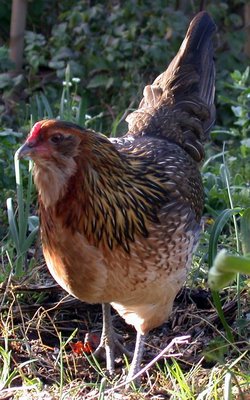 Araucana? Ameraucana? Easter Egger? Mutt? Much has been written about the mixture of breeds you might get if you buy a chick from a hatchery with any of these labels attached to her. Ours came from Belt Hatchery, and there are similarities to some of the "pure" Araucana photos I've seen on line, but she's clearly a mixture. She lays beautiful light blue eggs, and she's very sweet and smart and brave--she's always the one to chase the cats out of the yard so they can all forage in peace. She's sort of the second-in-command behind Eleanor.
Araucana? Ameraucana? Easter Egger? Mutt? Much has been written about the mixture of breeds you might get if you buy a chick from a hatchery with any of these labels attached to her. Ours came from Belt Hatchery, and there are similarities to some of the "pure" Araucana photos I've seen on line, but she's clearly a mixture. She lays beautiful light blue eggs, and she's very sweet and smart and brave--she's always the one to chase the cats out of the yard so they can all forage in peace. She's sort of the second-in-command behind Eleanor.
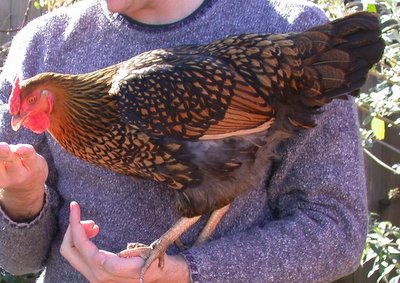 Golden-Laced Wyandotte. A beautiful bird. Lays very pale brown eggs, which are also a bit longer and narrower than Eleanor's. She's the most skittish of all our chickens, but as you can see, it's not like it's impossible to get near her or anything. She's just a little shy. Because we only have four chickens, it's easy for us to make an extra effort with her, as Scott is doing in this picture.
Golden-Laced Wyandotte. A beautiful bird. Lays very pale brown eggs, which are also a bit longer and narrower than Eleanor's. She's the most skittish of all our chickens, but as you can see, it's not like it's impossible to get near her or anything. She's just a little shy. Because we only have four chickens, it's easy for us to make an extra effort with her, as Scott is doing in this picture.Oh, my goodness. You have never seen anything as sweet or as sad as these skinny cage-raised hens who have now been rescued and sent off to live a happy life in the countryside. Why don't we have something like this in the US?

I just got back from the dentist myself (why, oh why, are we still drilling and filling? In this modern age, why isn't there a pill or a laser beam or something?), anyway, I don't really want to talk about that, but I do thank See My Chickens for picking up this BBC story about Beryl and Ginger, a couple of hens saved from slaughter who needed their beaks repaired so they could eat properly. Hens lay more eggs during their first year, and after that, when they are less productive, a commercial egg producer will usually--well, you know. Let's not speak of that, either.
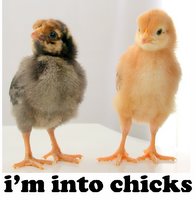
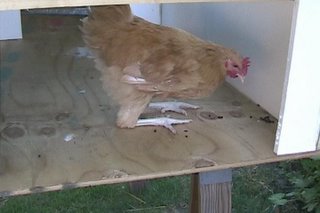
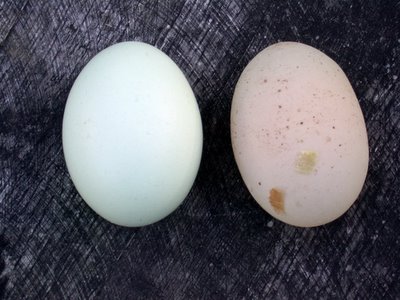 Actually, it's a no-shelled egg. The one on the left is a normal egg from Bess. The one on the right is what she produced today. (the spots are just dirt from us handling it.) It's surrounded by a membrane that's about the consistency of latex, but more fragile.
Actually, it's a no-shelled egg. The one on the left is a normal egg from Bess. The one on the right is what she produced today. (the spots are just dirt from us handling it.) It's surrounded by a membrane that's about the consistency of latex, but more fragile.
 It's hard to get a good picture of them all together, but I at least managed to get three of them facing the same direction (Abigail's hiding in the back.) They love nothing more than scratching around in the compost pile for worms. You can see how full Dolley's crop gets (she's the one on the right)--she packs enough food in there to last her a week, then sits and digests it all night.
It's hard to get a good picture of them all together, but I at least managed to get three of them facing the same direction (Abigail's hiding in the back.) They love nothing more than scratching around in the compost pile for worms. You can see how full Dolley's crop gets (she's the one on the right)--she packs enough food in there to last her a week, then sits and digests it all night. 


Peter in Devon is blogging about chickens, pigs, geese, and more. Check it out here.

 For a while there, we were bringing Eleanor inside every day to clean out her wounded toe in the bathtub. This is her ancestral home, the bathtub where she was raised under heat lamps from a tiny peep.
For a while there, we were bringing Eleanor inside every day to clean out her wounded toe in the bathtub. This is her ancestral home, the bathtub where she was raised under heat lamps from a tiny peep.
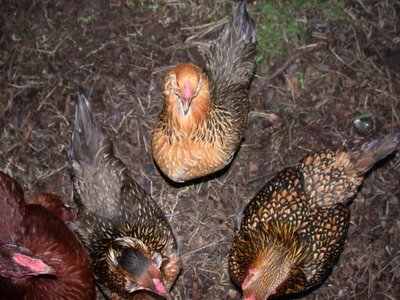 I've had trouble posting photos for the last couple of months, and I've just now fixed it. HA! OK, this is not a great photo of the girls, but I'm just so excited to have this working again that I'll put up anything. Here they are, gathered around for a handful of scratch. We haven't had much rain lately, so they've been very pleased to get to spend so much time outdoors.
I've had trouble posting photos for the last couple of months, and I've just now fixed it. HA! OK, this is not a great photo of the girls, but I'm just so excited to have this working again that I'll put up anything. Here they are, gathered around for a handful of scratch. We haven't had much rain lately, so they've been very pleased to get to spend so much time outdoors. 

OK, if you don't get this, I can't explain it. But if you're one of us, go check out Episode 4, where, in the first segment, they debate the merits of the Heifer International program I wrote about recently, in which you can purchase chickens (or, in this case, a goat) for a poor family somewhere else in the world.

The century egg, a.k.a. preserved egg, thousand-year egg, thousand-year-old egg, is a Chinese delicacy made by preserving duck (or less commonly chicken) eggs in a mixture of clay, ash, salt and lime for around only 100 days, despite the name. The yolk of the egg is concentrically variegated in pale and dark green colors while the egg white is dark brown and transparent like cola. The yolk is creamy and somewhat cheese-like in flavor with a strong aroma. The egg white has a gelatinous texture similar to cooked egg white, however with very little taste. The surface of the egg white is sometimes patterned with a snow-flake pattern.